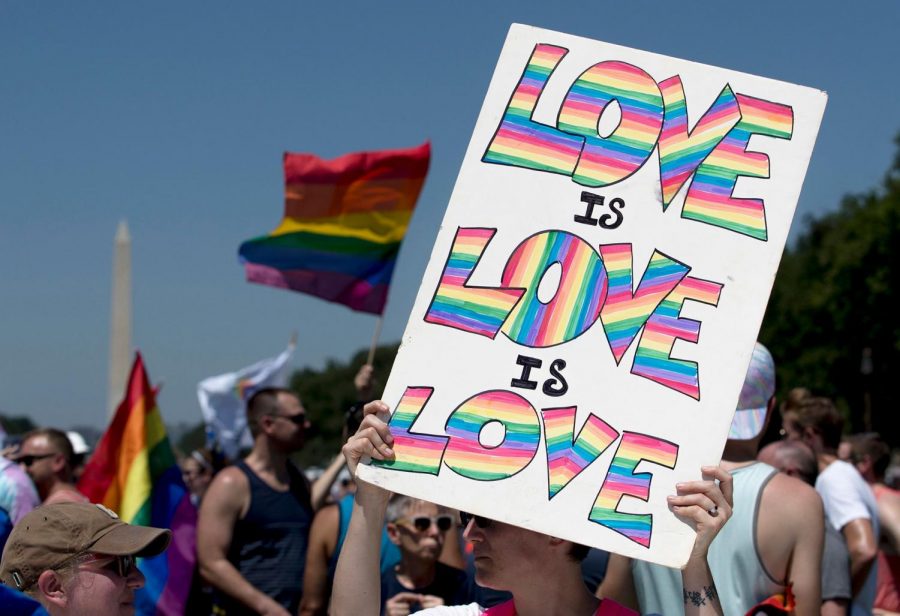The Fight for LGBTQ Rights Isn’t Over Yet
February 12, 2020
TW: mentions of discrimination against the LGBTQ community as well as conversion therapy
June 26th, 2015. Same-sex marriage is officially legal in all fifty states after a particularly controversial Supreme Court case. The bans on same-sex marriage in thirteen states were lifted, and in many of these states, couples “lined up to wed,” according to the BBC in their article “US Supreme Court rules gay marriage is legal nationwide.” But unfortunately, the fight for equal rights wasn’t over. While the U.S. became the twenty-third country to legalize same-sex marriage, according to The Washington Post, “The U.S. just joined a league of countries in which gay marriage is legal” many states have not, to this day, passed anti-discrimination laws that would give those who identify as part of the LGBTQ community the same rights as those who don’t.
The levels of protection for different issues vary from state to state and even from issue to issue. Some states have passed explicit laws that prohibit discrimination based on sexuality or gender identity. Others, while they haven’t passed any laws of their own, have determined that existing anti-discrimination legislature and court rulings concerning sex also apply to sexuality and gender identity. Still others, though, have neither passed laws or interpreted past prohibitions to disallow discrimination due to being a member of the LGBTQ community, making it perfectly legal in these states to discriminate against those who identify as queer based on that alone.
For example, according to the Movement Advancement Project’s Non-Discrimination Laws Map, in twenty-six states, there are no state-wide laws prohibiting private employers from discriminating on the basis of sexual orientation or gender identity. These laws would protect LGBTQ workers from being not hired, unfairly fired, or discriminated against because they are part of the LGBTQ community. In states that do have these laws, or have interpreted existing legislature as protecting the LGBTQ community, workers cannot be passed over for jobs simply because of their sexuality or gender identity, and also can’t be fired because of it. Workplace discrimination is also illegal in these states. In states that don’t have these protections, however, queer workers are at constant risk of being fired for their identity and may have a hard time finding a job, since employers are legally allowed to not hire them, even if they’re the best person for the job, solely because of discrimination or prejudice. These twenty-six states contain 44% of LGBTQ people, meaning that almost half of LGBTQ people can face discrimination in the workplace or during the hiring process and can’t do anything about it since private employers are legally allowed to discriminate against them.
Things are particularly dangerous for youth, who have fewer rights and are under their parents’ roof. LGBTQ youth experience at a much higher rate than those who identify as straight and cisgender (non transgender or genderqueer), according to Human Rights Campaign, and there is little support on a federal level for those who find themselves homeless. Homelessness has a strong, adverse effect on mental health and can have lasting consequences. Often, queer youth find themselves homeless because of familial prejudices against the LGBTQ community. Without programs to support these youth, many have nowhere to go and nobody to support them and suffer because of it.
Many states also don’t have laws banning conversion therapy for minors. Conversion therapy is the idea of changing someone’s sexuality or gender identity to fit “traditional” views of sexual orientation and gender identity. According to the Human Rights Campaign, these practices have been largely denounced by medical and mental health professionals for years, but still, the lack of laws in thirty states against such treatment means that, according to The Williams Institute, as many as 20,000 LGBTQ youths will receive conversion therapy before they turn eighteen. The report also estimates that, if laws banning such therapy didn’t exist in other states, an additional 6,000 youth would receive conversion therapy. 698,000 adults in the U.S. have received conversion therapy at some point. Also, because the laws that have been passed concerning conversion therapy don’t ban religious organizations from attempting these sorts of treatments on minors, it’s estimated that 57,000 LGBTQ youth in all fifty states will be given conversion therapy from clergy or other religious leaders. Such treatment, though, has been proven to be ineffective and has a history of causing mental health issues in those who are put through it.
All of this just shows that, while we may want to believe differently, there’s still a long way to go until members of the LGBTQ community have the same rights as those outside of it. While legalizing same-sex marriage was a huge milestone and a large leap towards total equality, it didn’t solve everything. To reach complete equality, we need national laws prohibiting discrimination as well as banning practices such as conversion therapy that target and ostracize LGBTQ youth. We also need programs that will support youth who find themselves homeless, whether that involves shelters and support programs or programs that spread the idea of acceptance and equality to parents who may not be accepting of their children after they’ve come out as queer. While statewide protections are helpful, they would have to happen everywhere to be fully effective, and, in some, more conservative states, there seems to be little chance of that happening. Without action at the federal level, LGBTQ community members will continue to have to fight for their right to be treated the same as everybody else.






















































































































































